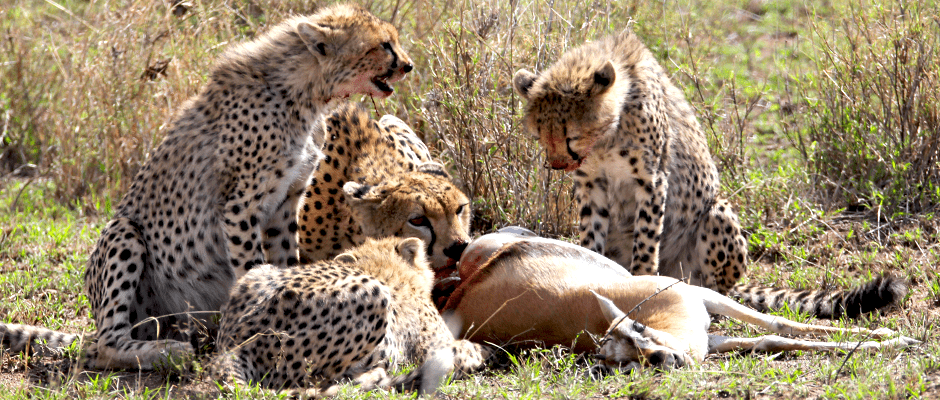Share this article
Who eats faster, male or female cheetahs?
How do mid-sized predators stay safe at meal times, despite larger predators lurking on the landscape? For cheetahs (Acinonyx jubatus), the answer depends on age and sex, according to new research presented at TWS’ 23rd Annual Conference last month in Raleigh, N.C. Juveniles and adult males use a “dine-and-dash” strategy, bolting food down before it can be stolen. Female cheetahs, in contrast, spend their time on alert, giving their cubs time to eat and play.
“Mothers have to juggle these competing pressures. They have to keep their cubs safe, they have to make sure they get enough to eat and they have to make sure they have time to learn necessary skills,” said Anne Hilborn, a PhD student at Virginia Tech. “Vigilance means you spend more time in a risky situation, but it also means that you lessen the risk of that situation and make it safer.”
Not all cheetahs face the same level of risk. Lions (Panthera leo) and hyenas (Crocuta crocuta) rarely kill full-grown cheetahs, although they do steal about 11 percent of cheetah kills, says Hilborn. Females with cubs risk more than males and adolescents, because lions and hyenas kill more than half of all cheetah cubs on the Seregeti. To find out how cheetahs manage this danger, Hilborn and her colleagues analyzed what happened at hundreds of cheetah kills, using detailed observations collected over 35 years as part of the Serengeti Cheetah Project.
The researchers hypothesized that mother cheetahs would rush through meals, minimizing their time in the risky situation. To their surprise, it was the males and adolescents that used this strategy. Males started eating about a minute after making a kill, while adolescents often started eating while their prey was still alive. In contrast, females waited about 11 minutes before staring to eat, and they took longer on the feeding itself. Hilborn now suspects that females were forced to slow down because of their cubs.
“Cubs have to eat…and that can take a while, because they’re not very good at it,” she said. “They take breaks to rest; they take breaks to play with their food. And while it might help them to develop prey skills and hunting skills, it doesn’t make for a fast-food experience.”
Meal times were especially extended for small prey items, because mother cheetahs sometimes brought smaller animals back alive, possibly as a way for the cubs to practice their hunting skills. Hilborn hasn’t published data on how long this process takes, but she says young cheetahs’ hunting skills are less than impressive.
“I’ve watched cubs take up to half an hour chasing, catching, and failing to kill gazelle fawns,” she said.
It wasn’t just mother cheetahs that spent a long time on meals; adult females without cubs behaved similarly. But most adult female cheetahs have been mothers at some point, so they might have learned to slow down while raising cubs in the past, says Hilborn.
With fast food out of the question, mother cheetahs turn to another strategy: vigilance. Compared to males and adolescents, female cheetahs spent significantly more time watching for predators, says Hilborn. This wouldn’t prevent a lion from stealing their kill, but it might enable them to escape with their cubs’ lives.
The findings could help explain how multiple predator species can coexist on the diverse Serengeti landscape, says Hilborn. More broadly, they demonstrate that predators can customize their strategies for staying safe.
“It shows that mesopredators are individually altering their behavior in order to deal with the level of risk that they face, which is not necessarily the same level of risk that another member of their species faces,” said Hilborn.
Header Image: A female cheetah and its three cubs feed on a dead Thomson’s gazelle in the Serengeti. ©Anne Hilborn








